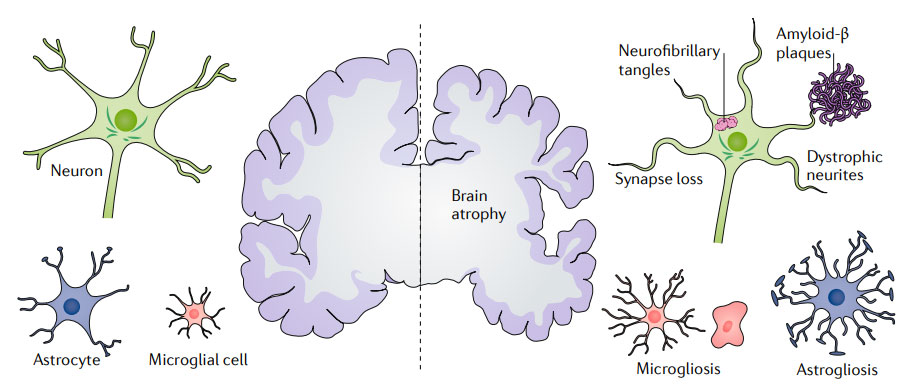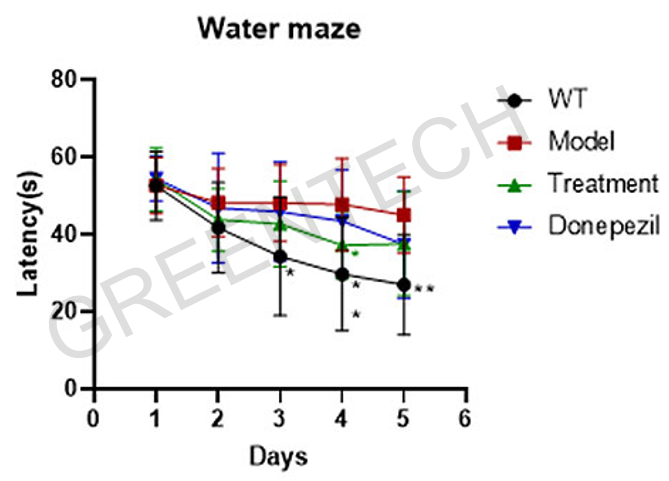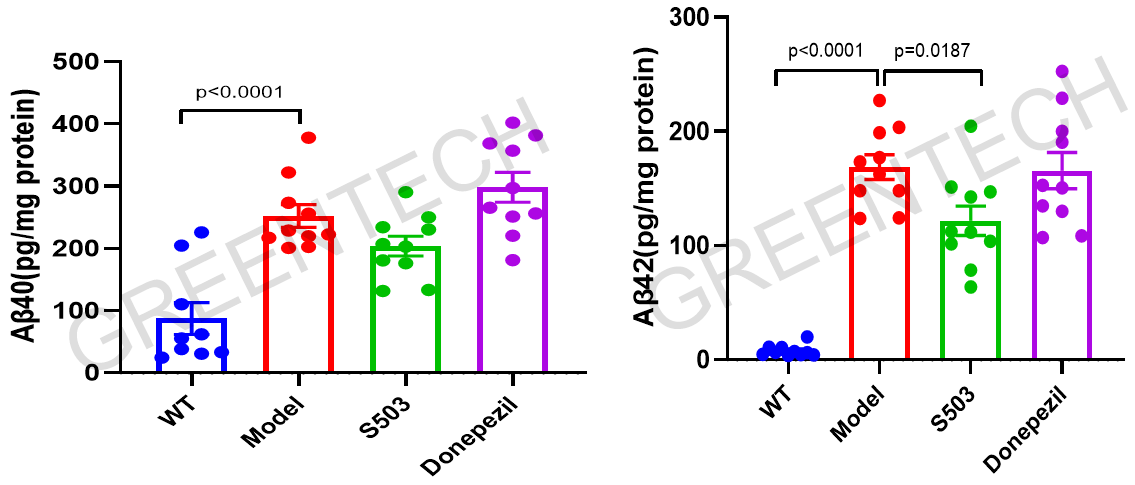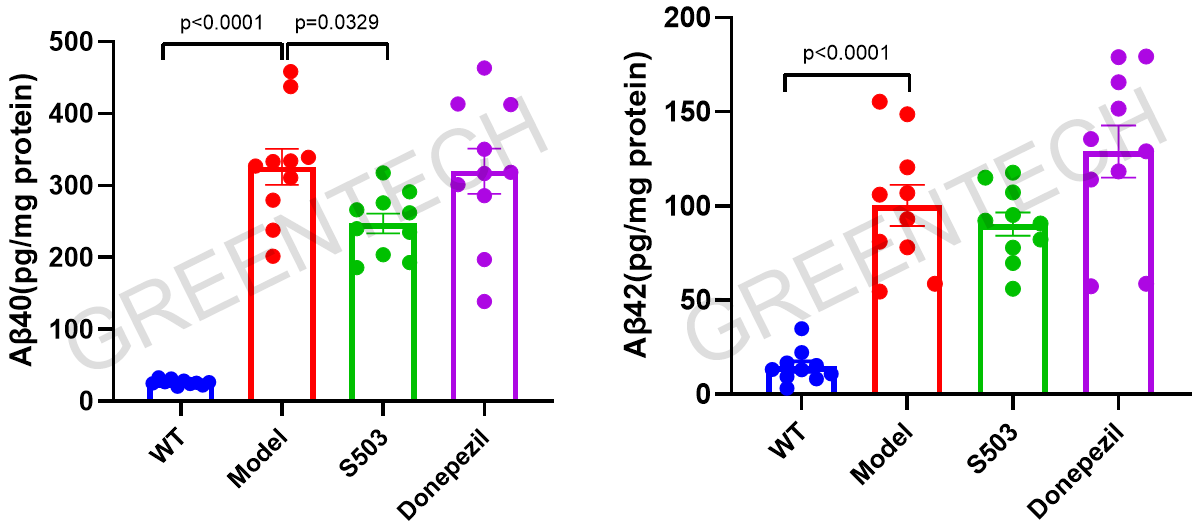Model of Alzheimer’s Disease (AD)
Dementia, one of the age-related devastating neurodegenerative diseases, is the leading cause of disability in the elderly population. Alzheimer’s disease (AD) is the most common type of dementia (60~80% of all cases). The main symptoms of Alzheimer’s disease are progressive and irreversible loss of memory, speech, reasoning, and cognition. The defining pathological hallmarks of AD include the accumulation of two key molecules, extracellular amyloid plaque and intracellular tau proteins in the brain. There is no treatment that cures AD, and the current available drugs may modestly modify symptoms. Greentech provides multiple animal models of Alzheimer’s disease for studies of AD pathogenesis and assessment of therapies.

Figure 1. The major pathological hallmarks of Alzheimer's disease (Götz et al., 2018)
Our Models of Alzheimer's Disease
1. APP/PS1 Transgenic Mice
The APP/PS1 double transgenic mice overexpress mutant human amyloid precursor protein (APP) and mutant human presenilin 1. Both mutations are linked to early-onset Alzheimer's disease. The APP/PS1 mouse model of AD is commonly used for studies of amyloid deposition, which shows age-dependent and region-specific progression of Aβ deposition, accompanied by increased microglial activation and astrogliosis.
Applications: to investigate pathogenesis of amyloid deposition and the efficacy of therapeutic approaches targeting Aβ deposition
Limitations: phosphorylated tau protein have been observed, but no mature neurofibrillary tangles (NFT)
2. SAMP8 Mice – Spontaneous Senescence Model
The senescence‐accelerated mouse prone 8 (SAMP8) strain displays early senescence, early deficits in learning and memory, tau and amyloid precursor protein (APP) transcriptional machinery. The SAMP8 mice have been widely used in aging research such as brain atrophy.
Applications: suitable for pathogenesis and pharmacology studies in the field of AD and other aging diseases
Limitations: high cost, scarce tau pathology
3. Scopolamine Induced AD Model
Scopolamine is a competitive antagonist of acetylcholine that can antagnoize muscarinic acetylcholine (ACh) receptors, causing deterioration of central cholinergic neurons and memory and cognitive deficits. Single administration of scopolamine can induce significant learning and memory impairment, and 4-week administration can further induce increased Aβ and phosphorylated tau accumulation in the brain.
Applications: scopolamine-induced AD model is a useful pharmacological tool to study AD pathogenesis and assess of AD drugs.
Limitations: reversible memory and cognitive deficits; Scopolamine blocks the central M receptors in a nonspecific manner, and animal may develop adverse reactions that affect behavioral evaluation, such as anxiety and increased voluntary physical activities.
Animal Species
Mice, rats
Clinical Assessment
(1) Neurobehavioral testing: Morris water maze, step through test, novel object recognition, Barnes maze, social interaction test, open field, rotarod test, elevated plus maze
(2) Aβ detection: ELISA, IHC
(3) Tau protein detection: WB
(4) IHC: neurons, microglial cells, astrocytes, NFTs
(5) Detection of AChE, ChAT, Ach: ELISA (for scopolamine-induced model of AD)
(6) Neuroinflammation detection
(7) Oxidative stress detection
Case Study
Animal model of Alzheimer’s disease: APP/PS1 transgenic mice

Figure 1. Water maze test.

Figure 2. Aβ40 and Aβ42 levels in the cortex.

Figure 3. Aβ40 and Aβ42 levels in the hippocampus.
References
1. Mima Y, Izumo N, Chen JR, Yang SC, Furukawa M, Watanabe Y. Effects of Coriandrum sativum Seed Extract on Aging-Induced Memory Impairment in Samp8 Mice. Nutrients. 2020 Feb 11;12(2):455. doi: 10.3390/nu12020455.
2. Congdon EE, Sigurdsson EM. Tau-targeting therapies for Alzheimer disease. Nat Rev Neurol. 2018 Jul;14(7):399-415. doi: 10.1038/s41582-018-0013-z.
3. Götz J, Bodea LG, Goedert M. Rodent models for Alzheimer disease. Nat Rev Neurosci. 2018 Oct;19(10):583-598. doi: 10.1038/s41583-018-0054-8.
4. Tang KS. The cellular and molecular processes associated with scopolamine-induced memory deficit: A model of Alzheimer's biomarkers. Life Sci. 2019 Sep 15;233:116695. doi: 10.1016/j.lfs.2019.116695.
Inquiries
Request a quote now, or email us at BD@greentech-bio.com to inquire about our services or obtain a quote for your project.












